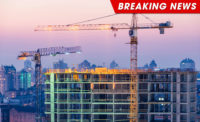Visit Vetrotech Saint-Gobain North America at AIA24

In honor of World Environment Day, June 5, Vetrotech Saint-Gobain North America has one question for architects: are you ready to decarbonize with glass? World Environment Day challenges us all to actively engage in protecting and restoring the earth. On the 50th anniversary of this annual event, Vetrotech encourages all of our partners in design and construction to engage with us in recognizing how building material selection impacts climate change and commit to making eco-friendly design selections.
While today’s advanced glass products play an invaluable role in allowing natural daylight to enter buildings, reducing the need for artificial lights without adding to a building’s cooling or heating load, architects and their partners must look beyond installation advantages to consider upstream emissions.
Embodied carbon represents the carbon emissions released during the lifecycle of a building material, from the extraction of the raw materials needed to produce it to processing and disposal of waste at the end of its useful life. Between 65% and 85% of total embodied carbon emissions are produced during the production phase — raw material acquisition, supply, and transport and manufacturing.
Sustainability is a core value for Vetrotech and all Saint-Gobain companies, and it drives the development of both the products we make and the production methods we use. It’s this combination of technological innovation and production enhancements that led to the release of CONTRAFLAM® One – a single-chamber fire-rated glass that features up to 35% less embodied carbon for 120-minute rated products than conventional multi-chamber or multi-laminate solutions.
Because CONTRAFLAM One can achieve fire ratings from 60 to 120 minutes using only two pieces of glass and a single foaming interlayer, it requires fewer raw materials and less energy to produce than the original CONTRAFLAM product. In addition to its revolutionary sustainability properties, the product also offers increased clarity and
reduced weight. This combination of features affords architects a protective material that enables greater design flexibility than previously possible.
To further reduce our impact on the environment, Vetrotech takes a three-step approach to reducing emissions during the production phase that emphasizes 1) emissions tracking, 2) strategies to reduce emissions through production enhancements, and 3) the purchase of renewable energy certificates. Our work to lower carbon emissions at every stage of production helps architectural projects reduce embodied carbon in line with LEED v4.1 requirements.
At the AIA Expo, June 6-7, 2024, in Washington, D.C., Vetrotech representatives will challenge architects to consider how they can employ glass to achieve their decarbonization goals by addressing three significant questions:
1. Can we decarbonize with glass?
2. Why decarbonize with glass?
3. How can we decarbonize with glass?
Vetrotech will be exhibiting alongside sister companies SageGlass and Saint-Gobain Glass in Booth #2129 as part of Saint-Gobain Specialty Glass Solutions. With our experts’ insight, attendees can expect to leave better prepared with strategies for leveraging Saint-Gobain’s complete range of eco-friendly glass products to help move future projects closer to carbon neutral.
To learn more about how our manufacturing processes and products support environmental and community health, we invite you to explore Vetrotech Saint-Gobain North America’s Sustainability Commitments or connect with our team to schedule a time to visit Saint-Gobain Specialty Glass Solutions in Booth #2129 at the AIA Expo.
Looking for a reprint of this article?
From high-res PDFs to custom plaques, order your copy today!



